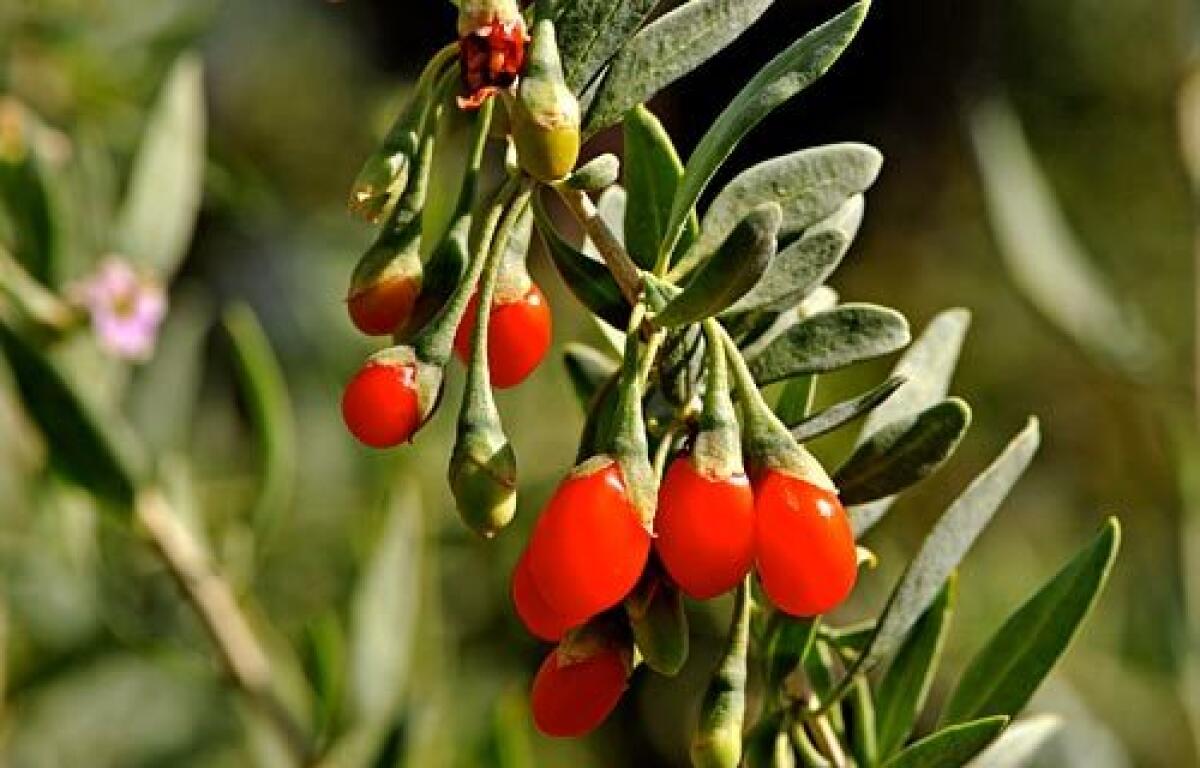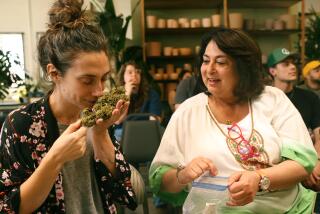Goji taunts North American farmers

- Share via
Reporting from Dinuba, Calif. — Can it be that goji, the supposed legendary miracle fruit of ancient Tibet, is being grown in Dinuba? Nothing is surprising when it comes to this tiny orange berry. Virtually unknown in the United States five years ago, it is now seemingly everywhere, in martinis, granolas, nutritional supplements and even Lindsay Lohan’s tanning spray.
But so far this much-hyped “superfruit,” so trendy and expensive, has been available only in processed form, in imported juices, powders and dried berries; the fresh berries themselves, eagerly sought by aficionados, have been unobtainable in the U.S.
That may be changing. On a broiling afternoon a month ago at his farm southeast of Fresno, Richard Burkart grinned as he picked a row of scraggly, pale green goji bushes to gather a handful of berries, which he cradled as if they were gold.
The berries had a mild, sweet, tomato-like flavor, with vegetal, rose and red pepper notes. Burkart was pleased and talked about goji in plastic clamshells to be sold at farmers markets for $8, $10 or more.
But two weeks later, most of the bushes were bare.
“The birds have been annihilating the berries, and the bushes aren’t flowering as much as they were,” said Burkart.
Goji is a fruit embroiled in controversy and confusion, starting with its name: It’s called Lycium barbarum by botanists, and gou-qi in Mandarin, which has been translated as wolfberry, and anglicized as goji.
Whatever the name, it’s a member of the Solanaceae family, related to tomatoes, potatoes and peppers.
The Chinese have gathered goji from the wild and grown it in kitchen gardens since antiquity, chiefly to use the dried berries -- which resemble red raisins, though drier, tarter and slightly herbaceous -- in traditional herbal medicine, in tonic soups and teas.
Commercial cultivation started in China about 1950, and greatly expanded in recent years, as scientists discovered that the fruit is rich in nutrients and antioxidants, and marketers started claiming that it combats aging, boosts the immune system, prevents cancer and improves vision. Some such benefits may be verified eventually by human clinical trials, but so far the claims far exceed the evidence.
The largest and most renowned production district for medicinal goji, with 180,000 acres, is Ningxia Hui, a small autonomous region in north-central China, south of Inner Mongolia. Some unscrupulous marketers, seeking to cash in on Tibet’s exotic spiritual allure, claim that their dried goji berries are grown or even foraged in the wild there, but this is almost always a hoax, as scientists confirmed during my monthlong tour of China last autumn.
Several years ago Oliver Garner, the farmers market manager for Burkart Farms, was trying to sell a high-priced goji nutritional supplement for a multilevel marketing company but quit after finding that profits were elusive; he was also disturbed that the potion contained preservatives. Looking for a purer alternative, he ordered a few goji plants from a nursery in Utah and planted them in his yard; when these flourished and fruited, he propagated more plants by seeds and cuttings, and set out a 425-foot row at the farm southeast of Fresno, flanked by persimmons and blackberries.
There have been at least a dozen other attempts to grow goji for fruit in North America, and none have yet brought fruit to market, for one reason or another.
“The plants didn’t do well, they just sat there,” said Alex Avila, whose family farms in Hanford.
Timpanogos Nursery, from which Garner and many others bought their goji plants, had 18 acres coming into production last year, but Travis Klingler, a partner, said that “family problems” forced him to till under the trees. He is now out of the goji business.
In Arkansas, too much rain bedeviled Richere Tomkins, while deer devoured Jesse Gillespie’s planting in Kentucky.
The plants fetch high prices, and many promoters are secretive. Goji “is not something I talk about for free,” said Robert Matthies in British Columbia, adding that “there’s a reason why thousands have failed to grow this.”
The most ambitious goji-growing project is headed by Terry Switenky of Wolfberry AgroDevCo. in Saskatchewan, who has a cooperation agreement with the leading goji research institute in Ningxia. He said that he has spent 10 years breeding new varieties and that he and his partners were planning to plant thousands of acres of goji but declined to provide specific details.
Much still to learn
As with so many new crops, there’s been a steep learning curve for growers. Most have planted trees derived from seedlings, but these are much less productive than the best Chinese varieties, which need to be grown from cuttings to come true, and are just now becoming available. Jim Gilbert and Lorraine Gardner of One Green World Nursery traveled to Ningxia in 2005 and returned with the leading variety, Ning-qi No. 1, which they are selling as Crimson Star.
There’s no doubt that goji can be grown in the United States: In Wyoming and Montana it’s so prolific that it has been classified as a noxious weed. According to Iowa-based Jason Qing of Dreamland Goji, a native of Ningxia who trained as an agricultural meteorologist, Northern California and the inland Northwest may be the most suitable areas for goji. “They like a hot dry summer, with high daytime temperatures, but cool at night,” he says.
Meanwhile, about a dozen scientists in the United States and Canada have started test plantings. However, Eric Hanson of Michigan State University, who traveled to Ningxia in 2007 to research goji, says that because harvest is so labor-intensive, mechanized picking, not yet practical, will be essential to produce fruit competitively here.
Even if farmers succeed in growing regular crops, the berries will be a challenge to sell as fresh fruit, because they are very perishable. But it is likely that health-conscious goji aficionados, eager for unsprayed, domestically produced fruit, will provide a ready market.
“I almost fell over when I heard the Burkarts will have fresh goji,” said Akasha Richmond, who features the dried berries at her Akasha restaurant in Culver City. “I’m crossing my fingers.”
More to Read
Eat your way across L.A.
Get our weekly Tasting Notes newsletter for reviews, news and more.
You may occasionally receive promotional content from the Los Angeles Times.







